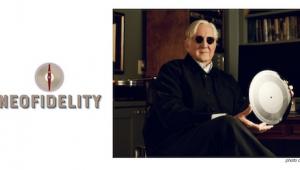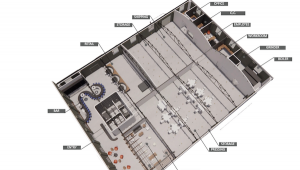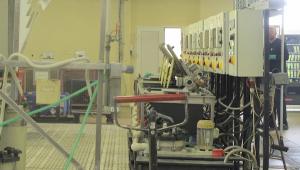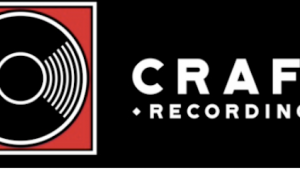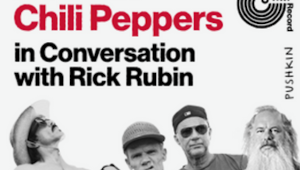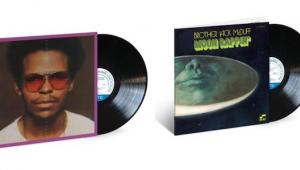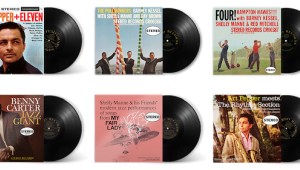Why bother? If it was all analogue I would go for it. If one has either the 45 or the 33.3 LPs from AP you are all set. If you want more, buy the 3 ceedee box put out in 2005. No analog, no purchase on this one!
Bill Evans’ “ The Complete Village Vanguard Recordings 1961” Coming From Concord Music Group

18 months of work by Evans, drummer Paul Motian and LeFaro came to fruition that day. These timeless performances in which the trio interacted as an organic whole, with each player at times leading the way rhythmically and even melodically have become treasured by generation after generation of jazz fans. They don’t date.
Eavesdropping on the proceedings, especially given the remarkably transparent and pristine recording quality, makes for thrilling listening, particularly on recent double 45rpm editions issued by Analogue Productions.
Reissue producer Bill Belmont perused the Concord vaults looking for and finding every last snippet of originally recorded tape in order to create as complete as possible a documentation of the five sets the trio performed that day.
The performances and the audience reaction, much of which had been either edited or faded out have been restored and sequenced in the original order. “The task,” according to Belmont, was to “…find the reels—if they existed—and try and make a reconstruction of everything that was recorded….to try to make the show flow as closely as possible to what had been recorded.”
Even the most committed analog diehard will understand that the only way to do this was in the digital domain, so the 4 LP set was strung together in ProTools. We all understand that, right?
However, what will be more difficult to understand and accept that the transfers were done at 44.1K/24 bit. Why? Why? Why? In 2014 are we saddled with an LP set cut from CD sampling rate resolution? Even if the producer and engineer Joe Tarantino, who loaded the material into ProTools (A/D converter not specified) erroneously believed that 44.1k sampling was “transparent” to the source, why not do it at 88.2K or 96K just for the F…K OF IT?
It is almost as if they are trying to prove a point that few of us believe: that CD’s sampling rate and the necessary brick wall filtering at 20K required to produce 44.1k files was transparent to the source. Why else in 2014 would anyone produce files at that resolution (other than to make easier decimation for the CD edition). In some ways this reminds me of The Beatles box set production.
In any case, the ProTools files at 44.1k/24 bit were loaded back into ProTools and used by George Horn to cut the lacquers. Who plated and pressed was also not specified. Of course we hope RTI, Pallas, Gotta Groove, QRP or Optimal.
Included in the box is a 12 page booklet containing new liner notes by reissue producer Belmont, the original Orrin Keepnew LP liner notes, reproductions of Keepnews’ session annotation ad photographer Steve Schapiro’s proof sheets shot at the performances (lucky photographic assignment!) and a “stunning” metallic and black poster of the famous cover.
At Analogplanet.com we are always open to be proven wrong about our digital assumptions. We hope a comparison between these LPs and the all-analog versions issued by Analogue Productions of the edited tapes will prove us wrong, but based on past experience, why the producer chose to digitize the material at 44.1k is an unexplained and frustrating mystery.
One thing to consider: often in cases like this, the original edits were done as much to give listeners the best performances as to shorten the program to fit the LP’s limitations, so how much musical value is contained in the restored tracks remains to be heard. However, having the fully restored day and evening’s performances will be for many a thrilling experience.
Here is the track listing for The Complete Village Vanguard Recordings, 1961
Disc 1
Side A:
1. Spoken Introduction 00:43
2. Gloria's Step (Take 1, Interrupted) 5:41
3. Alice In Wonderland (Take 1) 6:57
Side B:
1. My Foolish Heart 4:55
2. All Of You (Take 1) 8:14
3. Announcement And Intermission 1:44
Disc 2
Side A:
1. My Romance (Take 1) 7:11
2. Some Other Time 5:02
3. Solar 8:57
Side B:
1. Gloria's Step (Take 2) 6:10
2. My Man's Gone Now 6:21
3. All Of You (Take 2) 8:29
Disc 3
Side A:
1. Detour Ahead (Take 1) 7:17
2. Discussing Repertoire 00:31
3. Waltz For Debby (Take 1) 6:46
4. Alice In Wonderland (Take 2) 8:31
Side B:
1. Porgy (I Loves You, Porgy) 6:09
2. My Romance (Take 2) 7:26
3. Milestones 6:31
Disc 4
Side A:
1. Detour Ahead (Take 2) 7:41
2. Gloria's Step (Take 3) 6:48
3. Waltz For Debby (Take 2) 7:00
Side B:
1 All Of You (Take 3) 8:18
2. Jade Visions (Take 1) 4:12
3. Jade Visions (Take 2) 3:57
4. ...A Few Final Bars 1:15
- Log in or register to post comments


I know this is the wrong dark alley to say thin, but the 2005 CD set sounds excellent. Joe Tarantino did an extremely good job on that set.
Others have probably already pointed out that you omitted the track listing for the 3rd CD/4th LP featuring the third evening set: Detour's Ahead, Gloria's Step, Waltz for Debby, All of You, Jade Visions (take one), and Jade Visions (take 2).

I recently bought Concord's reissue of Coltrane's "Afro Blue" and was left underwhelmed with the sound quality (it is now in my out bin as a waste of money). I though it had that low-res sound of "clarity" without finesse that drained the life from the listening experience - especially compared to some original Pablo's of Coltrane I have - it makes me wonder did this get the same treatment descibed above - or had I just had a crap day when I played it (I think not)

Not taking a position on the 16/44.1 discussion, Sam Tellig has an interesting article in the November 2014 issue of Stereophile. In his review of the La Rosita Alpha New, Sam quotes the manufacturer as saying, "Not one public or commercial operating system can play these files [24-bit/192kHz] as precisely as 16/44.1--only real-time operating systems with very special computing equipment." Does the last part of that sentence refer to ProTools? I was just wondering. The manufacturer goes on to say, "If we are not precise, we lose quality. If we compress data, we need more time to uncompress, and this results in loss of sound quality." Does the data get compressed during the vinyl mastering process? Again, just wondering.

It has to do with the tempo of the music being damaged.
Are the "redbook" versions made from the same master that was used for the vinyl? How would you even know? Have you ever compared 16/44.1 rips with 24/96 rips made from the same vinyl?
The premise of the article is that playing CD's in real time (spinning on a CD player) produces timing errors that cannot be avoided. These guys even go as far as to say, "The limitations of current computers' software and protocol do not allow playing hi-rez files effectively without yielding high jitter." I'm not sure if that applies to ProTools. I was just wondering.

I was at the Newport Audio Show and a guy from Raidho speakers said the same thing that often Redbook sounds just as good and sometimes better than high res digital because the conversion from digital to analog requires much higher precision with high res that current technology can't do very well. I don't think I agree based on what I have read here and at Audiostream.com but I haven't listened to much high res yet.

I am asking if you compared playback of two files of different resolution using the same software/DAC/amplification/cables/speakers. A CD made from the same rip doesn't prove or disprove the point, because you are spinning the CD on a CD player. Downsampled files burnt onto a CD-R played back by a CD player are not a valid comparison. The files should be created using the same software, vinyl playback gear, AD converter, cables & computer for a valid comparison.
Keep in mind, I don't have a dog in this fight. I'm just asking questions. The Socratic method, you know?
I enjoy listening to _music_ in all of its forms. I have digital files (downloads and those I have ripped for myself from vinyl and cassettes), lots of vinyl bought from the late 50's till present, CD's (when LP's were virtually unavailable), SACD's, DVD-A's and Pure Audio Blu-rays.
If its your job to listen critically, that's totally understandable. But, for me, it can ruin my enjoyment of the performance. It would be a shame to deprive myself of the pleasure of listening to the complete Bill Evans' Village Vanguard Recordings due to some real, or imagined, difference in expected sound quality.

Quoting Sam's Space:
"You can have Perfect Sound Forever, just as Sony said in 1983. What they didn't say was that you couldn't have it until 2014."
Also, I don't know if I understand the advantage of making vinyl versions from digital masters. As an example, I bought the vinyl version of Cecile McLorin Salvant's Woman Child. It had some definite flaws in the vinyl, so I requested a return. Before I received the RMA, I downloaded a 24/96 AIFF of one of the tracks. To my ears, it sounded superior to the same track on the LP played back on my system, so I bought the digital download of the entire album. I have a relatively inexpensive Schiit Bifrost DAC and a Rega RP3 turntable with Elys cartridge and TT-PSU, and a NAD PP4 phono preamp.

My playback with my "relatively modest" analog system sounds better to my ears playing the recent AP 200-gm vinyl record than either of your digital versions of the Reiner Living Presence Scheherazade, even when I swap the channels to correct the mistake you made. The difference for the Salvant recording was that the LP was sourced from a digital recording.
I choose to invest my limited funds on music rather than relatively immodest gear. Most people my age have limited high-frequency hearing. Mine was helped along by the US Army and the feedback-laden psychedilic rock of the late 1960's. You may be the exception, but I can't tell the difference between 24/96 and 24/192 (other than price).

I have the recent AP 200-gm vinyl. The same one that you ostensibly used for one of the files. The channels are as most everyone has said here: first violins on the left, cellos on the right. This is a normal layout for a symphony orchestra. Surely you know that.
As I have said in a previous post, I also have the Chesky remastering and the half-speed RCA Red Seal. All have the same channel layout. It really is a stretch to believe that both of your copies (pressed 54 years apart) are reversed to the normal layout and somehow every copy that I (and many others) have is different. All of mine agree with a normal symphony layout and yours don't.
You made a mistake, and you need to admit it. Perhaps you connected your high-dollar cartridge incorrectly. Who knows? The results prove the point. Pull out your Rega Planar 3 'table and check it out. You don't need to have the Better Records version since both your files had the same (incorrect) channel layout.

Both of your files have the same (reversed) channel layout. We are saying that the channels on your files are both reversed from the layout on our copies of this recording. Had you taken the time to check this out, you would already know that.

It's your unapologetic arrogance.
The existence of this website is predicated on your believed superiority of analog recording methods and, as a subset of that, vinyl. I get that. But what angers me is when you get to the point where you have to do a comparison, then you don't have time for it. You have to move on. You blow me off by saying you could(n't) care less.
Could it be that you are predisposed to not favor 16/44.1 recordings because it threatens your very existence? This could be a subconscious thing. I don't have any way of knowing.
New discoveries are made all the time. Theories are constantly being proven or found to be false. As I have said several times, I am not taking sides in the analog vs. digital or the hi-res vs. redbook debates. I just found it interesting that there are some theories out there that might shed new light on the validity of the supposed advantage of higher sampling rates on the sound of the final product. You dismissed those theories out of hand, and presented a flawed example to support your conclusion. When I pointed out the flaw in your comparison, you blew me off.
Now you say that you have to move on. You don't have the time to compare your files to each other and to the AP original. That's understandable. But why has it taken so long for you to realize that you did make a setup mistake. My post on 10/9 in the thread for the original file test said essentially the same thing that I posted above. Others posts were similar to mine. Could it be that you were so sure that you didn't make a mistake that you didn't take the time to actually consider the details of what others were saying?
Fortunately I am able to filter out the arrogance and the grammar school side comments, because I do get a lot of valuable information from this web site. An example of that is your recent review of the IMPEX reissue of Miles Davis' E.S.P. See my post in that thread. But I get angry when your comments become personal and condescending. I find your my-way-or-the-highway attitude offensive. I'm sure it has something to do with your success. Arrogance often does.

This may become repetitious, but since you fail to recognize this quality in yourself, here goes:
Definition of arrogance:
"an attitude of superiority manifested in an overbearing manner or in presumptuous claims or assumptions"
The last part of that applies more to you than the first.
Let's take a closer look at some of your comments:
"Of course Sam would explain the position. That's the job. But that doesn't count as an endorsement! Just reading '16/44.1K' tightens my audio sphincter muscle after decades of CD sonic abuse. I hate the sound, my brain hates the sound and no amount of measuring or math will ever convince me that CD sound is acceptable, no less superior! And if anyone thinks my conclusion is based on 'bias' or whatever, I could care less! The bottom line is, in 2014 there's no reason for 44.1K sampling. That's my opinion and I'm sticking with it!" (The last part is your my-way-or-the-highway statement.)
This statement is very presumptuous and illustrates exactly what I am writing about. It's obvious that you haven't read Sam's article in the November Stereophile. If you had, you would have realized that his statement about "perfect sound forever" was tongue-in-cheek." That's just part of Sam's schtick. You would have also realized that the manufacturer was not claiming that 24/96 was inferior. Of course a higher sampling rate and bit depth captures more of the information available on the original analog tapes. The manufacturer is claiming that present technology does not allow for playback of hi-rez files without the introduction of timing errors. Do you know this statement to be false, or are you PRESUMING it is?
To carry this presumptuousness a bit further. do you actually know the reason that Concord chose to use the 2005 24/44.1 master to produce the forthcoming vinyl? You state, "in 2014 there's NO REASON (my emphasis) for 44.1K sampling." Let me propose a few. I'll start with the most obvious, i.e., cost. Concord is in business to make money, not to satisfy the whims of audiophile collectors like you and your readers. If both of these could be accomplished concurrently, then I am sure they would have done it your way. Also, do you know the condition of the various 54-year-old analog tapes? Could they have deteriorated or, in some other way, become unavailable in the 9 years since they were used to make the 2005 24/44.1 master?
You state, "Every time I've done redbook versus 96/24 comparisons the higher resolution wins." With this kind of past-predicts-the-future attitude, Edison would have never invented the electric light bulb.
When I pointed out that down-sampling a 24/96 file to 16/44.1 is a faulty method for comparison, you didn't have the time to make two separate files from the same source as I suggested. Again, you are PRESUMING that what you have done in the past was correct. This is textbook arrogance.
You stated that you did not make a mistake in producing those Scheherazade files. Many people said you had made a mistake, but, since you were so sure you hadn't, you didn't bother to investigate. Again, this is PRESUMPTUOUS.
You state. "I just have neither the time nor inclination to revisit rebook perfection, especially since this site is about vinyl and analog." Weren't you the one that wrote the article criticizing the use of a 44.1 file as the master? This article raised the question on your "vinyl and analog" site. It seems to me to be the height of arrogance to criticize a company for doing something, and then dismiss out-of-hand any reasons for them doing so that might possibly be valid.

It was placed at the end of the thread. Must have forgot to hit the reply button,

Downloaded the sample files from Channel Classics. I preferred the 24/96 version over the 16/44.1. The difference was slight to my old ears, but there definitely seemed to be more air & less congestion in the 24/96 version.

I have the original AP 33 1/3 Waltz For Debby as well as the 45rpm second set.
I recently picked up a single LP of previously unreleased material from the same dates. It was $1.99 from Stereo Jack's. Unfortunately there's a small vinyl bubble in side two causing a skip there, but otherwise, I'm happy with what I've got. Certainly a potentially interesting set, but dimmed by the mastering choice.

I'll agree with HalSF that the CD box sounds very good. Given this news, I think I'll just stay with that. I'm sad that I got back into vinyl too late to get the AP releases before they sold out. Guess I'll just have to wait a bit longer. Sigh.

If you want to really go for it, it looks like the AP Riverside box is still available:
http://store.acousticsounds.com/d/66242/Bill_Evans-Riverside_Recordings-...


...that AP is reissuing this set. It shows as "backordered" but they are taking the orders. No idea when the release date is, I decided to stick with my 1984 Riverside box.


Yeah, a lesson to us all: if you want to know what you're buying stick to this site!
So, thank you and keep going Sir!

They must have a thing about digital.
Using a 40 year old sampling rate today for stuff like this is just plain unacceptable.
If this was all analogue, I would already have my pre-order in.
Digital? 44.1/16? Forget it. Not a chance.
I wouldn't even bother downloading the files at 44.1/16.
Go back guys, take the tapes and do it again analogue. Or give the tapes to someone who will do a proper job.

I and my friends in Vienna would buy this set for any price, if at DSD or analog. But low digital resolution? Nobody serious will buy this. Haven't you done simple comparisons CD to vinyl up to today. Dead CD music on high end systems is unlistenable. After 10 minutes listening I get nervous and throw the CD in the bin. And, sadly, CD resolution on vinyl sounds even more horrible on my tubed equipment.

First, thanks for the info Michael! I was leaning to the "Nay" side as I figured this wasn't analog and I already have the AP 45RPM box, but was tempted by having the whole stint. But your info pushed me squarely to the "Nay" side.
Second, I think this is the place to bring up the idea of pushing record labels to use something akin to the SPARS code to inform the vinyl consumer of the A/D chain, but if it goes into the D domain to also provide the sample/bit rate.
Personally, I've emailed one indie label about it a while back for a reissue campaign they have, and lately I've been meaning to do it for some of the bigger indie labels - Matador, Sub Pop, Merge - as those are the three of the big non-audiophile labels I patronize, along with Light In The Attic, Mexican Summer, etc.
But instead of just one person finding out, or all of us finding out individually, it sure would be nice to have at least a voluntary standard. I assume most of the indie are in the digital domain at some point in the chain, but as is noted above there is a big difference between CD level transfers and hi-res transfers.
I figured with your success with the Beatles Mono box, this could be your next campaign.
Either way, keep up the good work!

Just want to take a minute to say that there is a lot right about spreading the 'versions' and 'alternate takes' across all sides of a specialist compilation -- cd or lp.
Absolutely nothing takes the joy out of a collector-item comp like this kind of track listing :
Side One: All Of You, All Of You (false start), All Of You (radio edit), All Of You (take 4, second chorus), All Of You (take 3)
Side Two: Waltz For Debbie (single version), Waltz For Debbie (alternate, extended bridge), Waltz For Debbie (add X on percussion), Waltz For Debbie (encore)
The informed consumer--- and who else would be buying a super-comprehensive collection with multiple, repeated tracks--- doesn't want all these versions massed together to compare the noise floor or the room tone or something. There is never a need to place them back-to-back. As they are on many a specialty compilation.
So a good thing.
J.

I think the idea behind something like what you describe is to present the tracks in the order they were recorded, complete or not. Listening to those sorts of "sessions" sets can be very informative but difficult if that's not what you're in the mood for. It's even more difficult with LPs, given the lack of "navigation." I have a copy of the complete Thelonius Monk on Riverside (22 LPs) that I've never been able to entirely get through because of that.

Agree; the more documentary and completist a collection wants to be, the more of a chance you'll get those strings of the same title, over & over again. Probably seems the most scholarly way to present the material, but wow-- makes for a spectacularly unrelenting and unappealing listen.
Suppose digital has the edge here-- playlisting, track sequencing and/or 'shuffle' can change the whole nature of the recording.

I won't purchase this given the CD resolution source, seems like a waste of vinyl to me. I would have purchased it had it been done with the love and respect it was given for the AP releases. If they were going to use a digital source, what happended to the 24/192 files? Waltz For Debbie sounds fantastic in the hi-res release.

I thought you were talking about a recent remastering. I see on Amazon that the 3-CD set was released in September of 2005. Are you saying that Concord is using that master for the 180-gm LPs?
Again, I don't have a dog in this fight. But, it seems to me, that down-sampling a 24/96 rip presupposes its superiority. As I understand it, 24/96 files use a brickwall filter (albeit less steep than 16/44.1) in playback. Would this come into play during your down-sampling of a 24/96 file?
I know your knowledge of this stuff is vastly superior to mine, and I'm really not questioning your position. I just found Sam's article interesting in that there is at least one audiophile manufacturer that is basing its $2000 product, at least partly, on the superiority of decoding 16/44.1 resolution music. Sam went to great lengths to explain the manufacturer's controversial position.

In my opinion, the files for comparison should be sampled individually from the same source. One should not be down-sampled from the other. Are you blowing me off ("The bottom line is, in 2014 there's no reason for 44.1K sampling. That's my opinion and I'm sticking with it!") Don't you mean you couldN'T care less? Or maybe you could. :-)

Why? Money, of course. With a limited audience, why spend lots of money recompiling and resampling, when they already have the master? So now they can crank out some vinyl and charge $100 for the set to people that want a vinyl version because it's "cool."
I guess I'll have to be satisfied with my 1973 Milestone (47002) top-loading 2-LP set with the fantastic liner notes by Michael James (The Village Vanguard Sessions). It includes all of the songs on this soon-to-be-released "Complete" 180-gm set, and its AAA!

Mike -
I'm really happy that you're around, and keeping us informed.
I've got a Milestone 2fer of the Village Vanguard sessions from the early 80's that I was just listening to, thinking that it sounded great, and was about to "upgrade" to this release. Jeesh - I assumed that it would be AAA.
Now I'm bummed because I think that it's Concord Music that's going to do a reissue of all of the Evans/Bennett material. I've got the AP from the first sessions, and was looking forward to the second.
Should I assume that Concord is going to step on that material as well?

As someone who was truly hoping for great sound on this vinyl release, I was disappointed to read your post. But I also have a question (I am not questioning you, but a confused consumer). I e-mailed one of the remastering engineers for this vinyl set before seeing your post, and was told "The original analog master tapes were indeed used for this project", though my follow up question about whether they were transferred digitally first and then the lacquers cut was not answered, though my first question, I think, implied that I was asking whether the records were cut from analog sources. Maybe the answer I received was not at all in conflict with your post, but would like to get as definitive and clear an answer as possible before plunking down any money on this. Thanks!

Just depends how sensitive you are - just like coffee or zillions of otherthings.
My phono stage is digital and i still way prefer good vinyl to CD's - my friends prefer CD's through no-digital amps - hey ho - what an interesting world with loads of things we think we understand.
Anyway the LondonPhilharmonic are issuing a 4 LP set of Brahms Symphonies mastered from 44khz24 bit

I bought this set the week before Thanksgiving. Total retail impulse. I had almost forgotten reading about its release. Got home and started to ferret information about it and when reading this thread realized that I had already read it back in October and had already known about the sampling rate of the transfer. I don’t know what was more disheartening, realizing it was a digital transfer, that it was a digital transfer that was not as high a sampling rate as is currently available, or that my memory is going the way of all things (joints, teeth, hair...).
The problem is I really want it. At least I really want the music. I want these sets, as played; I want to break free beyond the engineer’s creations that I have loved for so long on “Sunday At The Village Vanguard” and “Waltz For Debby”. Truthfully I would have bought this set on CD when it was released except that it escaped my notice that it even existed. But these days…I’ve only been back into vinyl since the beginning of this year; I find it very hard to bother with anything new on CD. It’s been like finding salvation after 25 years of wandering in the desert. Thank God I kept my turntable (even though I did foolishly turf a lot of records based on the “Oh, I have it on CD” blindness).
I dithered for a week or so, trying to decide if I should break the plastic or just return it. I cast my bread upon the waters the weekend after Thanksgiving.
As a package it is well done. A lot of care went into it and I am not so cynical as to think it was only created to capture “hipster” dollars. All of the included paper items are informative and engaging. The records themselves are flat, glossy, quiet. No extraneous artifacts of bad handling in the packaging process or any pressing detritus.
The sound is warm, detailed, spacious, musically engaging (at least to me). I have not been motivated to do extensive comparisons to my current OJC pressings; I limited it to one track, “Milestones” on “Waltz For Debby”. I found the OJC cut louder, warm but spatially a little narrower and maybe even a little murky. Not in any way clearly superior or inferior, just different. Frankly it sounds like a different mix. The differences are subtle but I like them both. I am told the OJC pressings are AAA but who the hell knows (Michael, can you confirm or deny?).
The bottom line on the complete edition is that it satisfies the desire to hear the uninterrupted sets but I will still listen to the familiar original released versions as well. All dependent on mood. Neither sounds wrong, both sound different. It is that musical rightness I am looking for and I know when it sounds wrong to me.
In the same purchase I also picked up the current OJC pressing of Coltrane’s “Black Pearls”. I had regrettably bought a copy of it on Amazon that turned out to be a Wax Time (I’m still learning the red flags of reissues). Don’t know where they sourced it, all signs point to a retail CD. That exemplified wrongness. The mix was wrong, just painful, bright, spatially confused. Like they loaded it into ProTools and pressed a default eq setting for an MP3 player. Ironically my only copy prior to this was the JVC XRCD and it sounds wonderful. The OJC pressing sounds “right”. Different from the XRCD mix but what I expected and wanted from vinyl. Actually it sounded even better in mono.
If you have managed to read this far and question my criteria for this evaluation and my listening context, my hearing has 51 years of mileage, no major damage and I consider live music to be the reference for everything. I have pieced together my system over the years to provide what I find musical and transparent to the source. Not reference by any means but it makes me happy within the budgets I have had available. Modest but I think it is honest.
AR-XA/Sumiko MMT/Grado M+ (mid ‘80s, 800Ω coils, recently potted, new MCZ stylus)
Vista Audio phono-1 mkII (40db gain, loaded at 10KΩ), BJC LP-1
Anthem Pre2L (nos Tungsram E88CC), Kimber Hero
Cary SLM100 (current production New Sensor EH KT88/Tung-Sol 6SN7GTB),
Kimber bi-wire, 4VS HF/8PR LF
Eminent Technology LFT-8B
Point of reference for digital playback:
Heart CD6000 (Marantz 6000, nos Tungsram E88CC), AQ Diamondback





